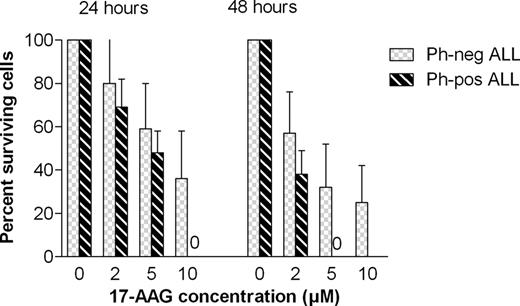Abstract
Abstract 3226
Heat Shock Protein 90 (HSP 90), a 90 Kda molecular weight protein, is one of the most abundant cytosolic chaperone, acting in protein folding, refolding and degradation and of particular importance in cell survival. HSP 90 is overexpressed in acute leukemia cells and this high expression is related with a poor prognosis. This ATP-dependent chaperone could be an interesting potential drug target. 17-AAG, a Geldanamycin derivates, is a HSP 90 inhibitor with a promising antitumor activity.
Very few reports have evaluated the effects of 17-AAG in acute lymphoblastic leukemia (ALL). The aim of this work is to study the cytotoxicity of 17-AAG and to compare Philadelphia positive (Ph+) ALL to common B-cell ALL.
Two human leukemia cell lines, Reh (common B-cell ALL) and SUPB15 (Ph+ ALL) were used in this study. We identified 63 consecutive patients treated in our institution for ALL (44 common B-cell ALL and 19 Ph+ ALL) and leukemic samples were collected at diagnosis from bone marrow aspiration after patient's consent.
The expression of HSP 90, pro-apoptotic BAX protein, anti-apoptotic bcl-2 and bcl-xl proteins was studied by flow cytometry. Cell lines and ALL patient's cells were cultured in RPMI 1640 and exposed to various concentrations of 17-AAG. Apoptosis was evaluated by an Annexin V and an activated caspase-3 staining by flow cytometry. Results were expressed as percentage of positive cells.
Pro-apoptotic effect of 17-AAG in Ph+ ALL cells was superior when compared to common B-cells with a 100% mortality rate after exposure to [10μM] 17-AAG for 24 hours for SUPB15 cell line whereas 24% of cell surviving was noted for Reh cell line. Similar results were observed with patient's leukemic samples (as shown in figure). The susceptibility of Ph+ ALL cells to 17-AAG was confirmed by the assessment of the IC50, estimated at 1.1 μM for SUPB15 cells versus 2.9 μM for ReH cells.
As assessed by Annexin V binding and activated caspase-3 staining, 17-AAG induced apoptosis in ALL cells. As regard Ph+ ALL, the median percentage of Annexin-V positive cells and caspase-3 positive cells after exposure to [5μM] 17 AAG for 24 hours was 54% and 57% respectively and increased up to 99% and 99,5% after exposure for 48 hours. Spontaneous apoptosis in control cell culture was measured in 1% at 24 hours and 3% at 48 hours.
The pattern of expression of HSP90 and apoptotic proteins was different between common B-cell ALL and Ph+ ALL cells. The percentage of HSP90 positive cells was 62% for Reh cell line whereas it reached 100% for SUP B15 cell line. As shown in the Table, the percentage of HSP90-positive cells and anti-apoptotic bcl-2 and bcl-xl proteins expression were higher for Ph+ ALL samples when compared to common B-cell ALL samples.
| . | HSP90 . | Bcl-2 . | Bcl-xl . | Bax . |
|---|---|---|---|---|
| Common B-cell ALL samples n=44 | 32.5% (±19.8) | 33% (± 21.4) | 28.5% (±19.5) | 33% (±17) |
| Ph+ ALL samples n = 19 | 79% (±7.5) | 82% (±8.4) | 84% (±7.8) | 12% (±4.3) |
| . | HSP90 . | Bcl-2 . | Bcl-xl . | Bax . |
|---|---|---|---|---|
| Common B-cell ALL samples n=44 | 32.5% (±19.8) | 33% (± 21.4) | 28.5% (±19.5) | 33% (±17) |
| Ph+ ALL samples n = 19 | 79% (±7.5) | 82% (±8.4) | 84% (±7.8) | 12% (±4.3) |
When ALL cells were exposed in culture to various concentrations of 17-AAG, there was no change in HSP90 expression but we observed a down-regulation in bcl-2 and bcl-xl expression and an up-regulation in bax expression.
In summary, we showed that HSP90 and anti-apoptotic proteins were expressed at a higher level on Ph+ ALL cells when compared to common B-cell ALL. High percentage of HSP90-positive cells was associated with high sensitivity to 17-AAG. 17-AAG is a new targeted therapy that induces the apoptotic death of leukemic cells via a caspase-3 dependant way. It would be interesting to test its antileukemic activity in combination with chemotherapeutic agents to study additional or synergistic effects. Despite therapeutic improvement with the development of tyrosine kinase inhibitors (TKI) in the treatment of Ph+ ALL, relapse remains a major problem. Considering that Bcr-Abl constitutes HSP 90 substrates and depends on this chaperone for its maturation and conformational maintenance, 17-AAG could be of particular interest for Ph+ ALL disease, in combination with TKI. We can hypothesise that this drug could restore the sensitivity to TKI treatment for patients with Bcr-Abl mutation.
No relevant conflicts of interest to declare.
Author notes
Asterisk with author names denotes non-ASH members.


This feature is available to Subscribers Only
Sign In or Create an Account Close Modal